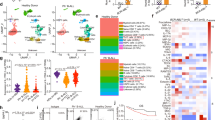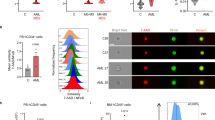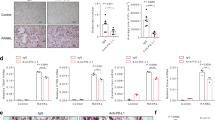Abstract
We have previously demonstrated that interleukin-17A (IL-17) producing T helper 17 cells are significantly elevated in blood and bone marrow (BM) in multiple myeloma (MM) and IL-17A promotes MM cell growth via the expression of IL-17 receptor. In this study, we evaluated anti-human IL-17A human monoclonal antibody (mAb), AIN457 in MM. We observe significant inhibition of MM cell growth by AIN457 both in the presence and the absence of BM stromal cells (BMSCs). Although IL-17A induces IL-6 production, AIN457 significantly downregulated IL-6 production and MM cell adhesion in MM–BMSC co-culture. AIN457 also significantly inhibited osteoclast cell differentiation. More importantly, in the SCIDhu model of human myeloma administration of AIN457 weekly for 4 weeks after the first detection of tumor in mice led to a significant inhibition of tumor growth and reduced bone damage compared with isotype control mice. To understand the mechanism of action of anti-IL-17A mAb, we report, here, that MM cells express IL-17A. We also observed that IL-17A knockdown inhibited MM cell growth and their ability to induce IL-6 production in co-cultures with BMSC. These pre-clinical observations suggest efficacy of AIN457 in myeloma and provide the rationale for its clinical evaluation for anti-myeloma effects and for improvement of bone disease.
This is a preview of subscription content, access via your institution
Access options
Subscribe to this journal
Receive 12 print issues and online access
$259.00 per year
only $21.58 per issue
Buy this article
- Purchase on Springer Link
- Instant access to full article PDF
Prices may be subject to local taxes which are calculated during checkout







Similar content being viewed by others
References
Hideshima T, Mitsiades C, Tonon G, Richardson PG, Anderson KC . Understanding MM pathogenesis in the BM to identify new therapeutic targets. Nat Rev Cancer 2007; 7: 585–598.
Munshi NC . Immunoregulatory mechanisms in multiple myeloma. Hematol Oncol Clin North Am 1997; 11: 51–69.
Prabhala RH, Neri P, Bae JE, Tassone P, Shammas MA, Allam CK et al. Dysfunctional T regulatory cells in multiple myeloma. Blood 2006; 107: 301–304.
Prabhala RH, Pelluru D, Fulciniti M, Prabhala HK, Nanjappa P, Song W et al. Elevated IL-17 produced by TH17 cells promotes myeloma cell growth and inhibits immune function in multiple myeloma. Blood 2010; 115: 5385–5392.
Prabhala RH, Munshi NC . Immune therapies. Hematol Oncol Clin North Am 2007; 21: 1217–1230.
Mosmann TR, Cherwinski H, Bond MW, Giedlin MA, Coffman RL . Two types of murine helper T cell clone. I. Definition according to profiles of lymphokine activities and secreted proteins. J Immunol 1986; 136: 2348–2357.
Fehérvari Z, Sakaguchi S . CD4+ Tregs and immune control. J Clin Invest 2004; 114: 1209–1217.
Wu Y, Borde M, Heissmeyer V, Feuerer M, Lapan AD, Stroud JC et al. FOXP3 controls regulatory T cell function through cooperation with NFAT. Cell 2006; 126: 375–387.
Peck A, Mellins E . Precarious balance: Th17 cells in host defense. Infect Immun 2010; 78: 32–38.
Saijo S, Ikeda S, Yamabe K, Kakuta S, Ishigame H, Akitsu A et al. Dectin-2 recognition of alpha-mannans and induction of Th17 cell differentiation is essential for host defense against Candida albicans. Immunity 2010; 32: 681–691.
Glocker EO, Hennigs A, Nabavi M, Schäffer AA, Woellner C, Salzer U et al. A homozygous CARD9 mutation in a family with susceptibility tofungal infections. N Engl J Med 2009; 361: 1727–1735.
Gaffen SL . Recent advances in the IL-17 cytokine family. Curr Opinion Immunol 2011; 23: 613–619.
Steinman L . A brief history of T(H)17, the first major revision in the T(H)1/T(H)2 hypothesis of T cell-mediated tissue damage. Nat Med 2007; 13: 139–145.
Bettelli E, Carrier Y, Gao W, Korn T, Strom TB, Oukka M et al. Reciprocal developmental pathways for the generation of pathogenic effector TH17 and regulatory T cells. Nature 2006; 441: 235–238.
Nakae S, Saijo S, Horai R, Sudo K, Mori S, Iwakura Y . IL-17 production from activated T cells is required for the spontaneous development of destructivearthritis in mice deficient in IL-1 receptor antagonist. Proc Natl Acad Sci USA 2003; 100: 5986–5990.
Kotake S, Udagawa N, Takahashi N, Matsuzaki K, Itoh K, Ishiyama S et al. IL-17 in synovial fluids from patients with rheumatoid arthritis is a potent stimulator of osteoclastogenesis. J Clin Invest 1999; 103: 1345–1352.
Dhodapkar KM, Barbuto S, Matthews P, Kukreja A, Mazumder A, Vesole D et al. Dendritic cells mediate the induction of polyfunctional human IL17-producing cells (Th17-1 cells) enriched in the bone marrow of patients with myeloma. Blood 2008; 112: 2878–2885.
Alexandrakis MG, Pappa CA, Miyakis S, Sfiridaki A, Kafousi M, Alegakis A et al. Serum IL-17 and its relationship to angiogenic factors in MM. Eur J Intern Med 2006; 17: 412–416.
Song XN, Yang JZ, Sun LX, Meng JB, Zhang JQ, Lv HY et al. Expression levels of IL-27 and IL-17 in multiple myeloma patients: a higher ratio of IL-27:IL-17 in bone marrow was associated with a superior progression-free survival. Leuk Res 2013; 37: 1094–1099.
Shen CJ, Yuan ZH, Liu YX, Hu GY . Increased numbers of T helper 17 cells and the correlation with clinicopathological characteristics in multiple myeloma. J Int Med Res 2012; 40: 556–564.
Lemancewicz D, Bolkun L, Jablonska E, Czeczuga-Semeniuk E, Kostur A, Kloczko J et al. The role of Interleukin-17A and Interleukin-17E in multiple myeloma patients. Med Sci Monit 2012; 18: BR54–BR59.
Scudla V, Petrova P, Minarik J, Pika T, Bacovsky J . Analysis of the serum levels of selected biological parameters in monoclonal gammopathy of undetermined significance and different stages of multiple myeloma. Neoplasma 2011; 58: 499–506.
Noonan K, Marchionni L, Anderson J, Pardoll D, Roodman GD, Borrello I . A novel role of IL-17-producing lymphocytes in mediating lytic bone disease in multiple myeloma. Blood 2010; 116: 3554–3563.
Tucci M, Stucci S, Savonarola A, Ciavarella S, Cafforio P, Dammacco F et al. Immature dendritic cells in multiple myeloma are prone to osteoclast-like differentiation through interleukin-17A stimulation. Br J Haematol 2013; 161: 821–831.
Oteri G, Allegra A, Bellomo G, Alonci A, Nastro E, Penna G et al. Reduced serum levels of IL-17 in patients with osteonecrosis of the jaw and in MM subjects after bisphosphonates administration. Cytokine 2008; 43: 103–104.
Miyahara Y, Odunsi K, Chen W, Peng G, Matsuzaki J, Wang RF . Generation and regulation of human CD4+IL-17-producing T cells in ovarian cancer. Proc Natl Acad Sci USA 2008; 105: 15505–15510.
Kottke T, Sanchez-Perez L, Diaz RM, Thompson J, Chong H, Harrington K et al. Induction of hsp70-mediated Th17 autoimmunity can be exploited as immunotherapy for metastatic prostate cancer. Cancer Res 2007; 67: 11970–11979.
Langowski JL, Zhang X, Wu L, Mattson JD, Chen T, Smith K et al. IL-23 promotes tumor incidence and growth. Nature 2006; 442: 461–465.
Tai YT, Podar K, Catley L, Tseng YH, Akiyama M, Shringarpure R et al. Insulin-like growth factor-1 induces adhesion and migration in human multiple myeloma cells via activation of beta1-integrin and phosphatidylinositol 3-kinase/AKT signaling. Cancer Res 2003; 63: 5850–5858.
Vallet S, Raje N, Ishitsuka K, Hideshima T, Podar K, Chhetri S et al. MLN3897, a novel CCR1 inhibitor, impairs osteoclastogenesis and inhibits the interaction of multiple myeloma cells and osteoclasts. Blood 2007; 110: 3744–3752.
Neri P, Tassone P, Shammas M, Yasui H, Schipani E, Batchu RB et al. Biological pathways and in vivo anti-tumor activity induced by Atiprimod in myeloma. Leukemia 2007; 21: 2519–2526.
Tassone P, Neri P, Carrasco DR, Burger R, Goldmacher VS, Fram R et al. A clinically relevant SCID-hu in vivo model of human multiple myeloma. Blood 2005; 106: 713–716.
Ruegsegger P, Koller B, Muller R . A microtomographic system for the nondestructive evaluation of bone architecture. Calcif Tissue Int 1996; 58: 24–29.
Iwakura Y, Ishigame H, Saijo S, Nakae S . Functional specialization of IL-17 family members. Immunity 2011; 34: 149–162.
Wang YH, Wills-Karp M . The potential role of interleukin-17 in severe asthma. Curr Allergy Asthma Rep 2011; 11: 388–394.
Li J, Lau GK, Chen L, Dong SS, Lan HY, Huang XR et al. Interleukin 17A promotes hepato-cellular carcinoma metastasis via NF-kB induced matrix metalloproteinases 2 and 9 expression. PLoS One 2011; 6: e21816.
Chabaud M, Fossiez F, Taupin JL, Miossec P . Enhancing effect of IL-17 on IL-1-induced IL-6 and leukemia inhibitory factor production by rheumatoid arthritis synoviocytes and its regulation by Th2 cytokines. J Immunol 1998; 161: 409–414.
Fossiez F, Djossou O, Chomarat P, Flores-Romo L, Ait-Yahia S, Maat C et al. T cell interleukin-17 induces stromal cells to produce pro-inflammatory and hematopoieticcytokines. J Exp Med 1996; 183: P2593–P2603.
Chabaud M, Garnero P, Dayer JM, Guerne PA, Fossiez F, Miossec P . Contribution of interleukin 17 to synovium matrix destruction in rheumatoid arthritis. Cytokine 2000; 12: 1092–1099.
Xu C, Yu L, Zhan P, Zhang Y . Elevated pleural effusion IL-17 is a diagnostic marker and outcome predictor in lung cancer patients. Eur J Med Res 2014; 19: 23.
Lin Y, Xu J, Su H, Zhong W, Yuan Y, Yu Z et al. Interleukin-17 is a favorable prognostic marker for colorectal cancer. Clin Transl Oncol 2014; 17: 50–56.
Han Y, Ye A, Bi L, Wu J, Yu K, Zhang S . Th17 cells and IL-17 increase with poor prognosis in patients with acute myeloid leukemia. Cancer Sci 2014; 105: 933–942.
Numasaki M, Watanabe M, Suzuki T, Takahashi H, Nakamura A, McAllister F et al. IL-17 enhances the net angiogenic activity and in vivo growth of human non-small cell lung cancer in SCID mice through promoting CXCR-2-dependent angiogenesis. J Immunol 2005; 175: 6177–6189.
Tartour E, Fossiez F, Joyeux I, Galinha A, Gey A, Claret E et al. Interleukin 17, a T-cell-derived cytokine, promotes tumorigenicity of human cervical tumors in nude mice. Cancer Res 1999; 59: 3698–3704.
Zhang Q, Liu S, Ge D, Zhang Q, Xue Y, Xiong Z et al. Interleukin-17 promotes formation and growth of prostate adenocarcinoma in mouse models. Cancer Res 2012; 72: 2589–2599.
Zhou L, Peng S, Duan J, Zhou J, Wang L, Wang J . A human B cell line AF10 expressing HIL-17. Biochem Mol Biol Int 1998; 45: 1113–1119.
Shen N, Wang J, Zhao M, Pei F, He B . Anti-interleukin-17 antibodies attenuate airway inflammation in tobacco-smoke-exposed mice. Inhal Toxicol 2011; 23: 212–218.
van den Berg WB, Miossec P . IL-17 as a future therapeutic target for rheumatoid arthritis. Nat Rev Rheumatol 2009; 5: 549–553.
Lubberts E, Koenders MI, Oppers-Walgreen B, van den Bersselaar L, Coenen-de Roo CJ, Joosten LA et al. Treatment with a neutralizing anti-murine interleukin-17 antibody after the onset of collagen-induced arthritis reduces joint inflammation, cartilage destruction, and bone erosion. Arthritis Rheum 2004; 50: 650–659.
Gensicke H, Leppert D, Yaldizli O, Lindberg RL, Mehling M, Kappos L et al. Monoclonal antibodies and recombinant immunoglobulins for the treatment of multiple sclerosis. CNS Drugs 2012; 26: 11–37.
Kurzeja M, Rudnicka L, Olszewska M . New interleukin-23 pathway inhibitors in dermatology: ustekinumab, briakinumab, and secukinumab. Am J Clin Dermatol 2011; 12: 113–125.
Yago T, Nanke Y, Kawamoto M, Furuya T, Kobashigawa T, Kamatani N et al. IL-23 induces human osteoclastogenesis via IL-17 in vitro, and anti-IL-23 antibody attenuates collagen-induced arthritis in rats. Arthritis Res Ther 2007; 9: R96.
Kotake S, Udagawa N, Takahashi N, Matsuzaki K, Itoh K, Ishiyama S et al. IL-17 in synovial fluids from patients with rheumatoid arthritis is a potent stimulatorof osteoclastogenesis. J Clin Invest 1999; 103: 1345–1352.
Hueber W, Patel DD, Dryja T, Wright AM, Koroleva I, Bruin G et al. Effects of AIN457, a fully human antibody to interleukin-17A, on psoriasis, rheumatoid arthritis, and uveitis. Sci Transl Med 2010; 2: 52ra72.
Genovese MC, Van den Bosch F, Roberson SA, Bojin S, Biagini IM, Ryan P et al. LY2439821, a humanized anti-interleukin-17 monoclonal antibody, in the treatment of patients with rheumatoid arthritis: A phase I randomized, double-blind, placebo-controlled, proof-of-concept study. J Arthritis Rheum 2010; 62: 929–939.
Leonardi C, Matheson R, Zachariae C, Cameron G, Li L, Edson-Heredia E, Braun D et al. Anti–interleukin-17 monoclonal antibody ixekizumab in chronic plaque psoriasis. N Engl J Med 2012; 366: 1190–1199.
Papp KA, Leonardi C, Menter A, Ortonne JP, Krueger JG, Kricorian G et al. Brodalumab, an anti–interleukin-17–receptor antibody for psoriasis. N Engl J Med 2012; 366: 1181–1189.
Acknowledgements
This work is supported by: Department of Veterans Affairs Merit Review Award1 I01 BX001584-01, NIH grants RO1-124929 and PO1-155258 (NCM) and P50-100707, and PO1-78378, (NCM and KCA). JSG is supported by the Department of Veterans Affairs Office of Research and Development through a Career Development Award-2. This work is also supported by MMRF senior award to RHP.
Author information
Authors and Affiliations
Corresponding authors
Ethics declarations
Competing interests
The authors declare no conflict of interest.
Rights and permissions
About this article
Cite this article
Prabhala, R., Fulciniti, M., Pelluru, D. et al. Targeting IL-17A in multiple myeloma: a potential novel therapeutic approach in myeloma. Leukemia 30, 379–389 (2016). https://doi.org/10.1038/leu.2015.228
Received:
Revised:
Accepted:
Published:
Issue Date:
DOI: https://doi.org/10.1038/leu.2015.228



